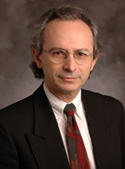Recent News
UNM Engineering team wins ASEE best paper for work on first-year engineering course
July 17, 2025
New director will enhance interdisciplinary engineering learning opportunities
July 2, 2025
Final SIRI cohort visits UNM campus
June 30, 2025
Perfetti receives ANS Landis Engineering Achievement Award
June 26, 2025
News Archives
Provost Announces Engineering Dean Finalists
November 24, 2010
 Provost Suzanne Ortega and Chair of the School of Engineering Search Committee Dean Doug Brown are pleased to announce the four finalists for the position of Dean of the School of Engineering. “This is a critical position at the University of New Mexico,” said Provost Ortega. “The timeline to get these finalists interviewed will be aggressive.”
Provost Suzanne Ortega and Chair of the School of Engineering Search Committee Dean Doug Brown are pleased to announce the four finalists for the position of Dean of the School of Engineering. “This is a critical position at the University of New Mexico,” said Provost Ortega. “The timeline to get these finalists interviewed will be aggressive.”
The candidates and the dates of their visits are:
December 6‑7, 2010
Dr. Craig H. Benson is Wisconsin Distinguished Professor and Chair of Geological Engineering at the University of Wisconsin-Madison. He also serves as Director of the Recycled Materials Resource Center (RMRC2) at the University of Wisconsin-Madison and is on the Management Board of the Consortium for Risk Evaluation with Stakeholder Participation (CRESP3).
RMRC is a research center focused on sustainable transportation infrastructure that is operated collaboratively by the University of Wisconsin-Madison and the University of New Hampshire for the US Department of Transportation. CRESP is a six-university consortium that facilitates cost effective and risk-informed cleanup and management of the nation's nuclear complex for
the US Department of Energy’s Office of Environmental Management. Dr. Benson also
served as Chair of Civil and Environmental Engineering at the University of Washington.
Dr. Benson has a BS from Lehigh University, MSE and PhD degrees from the University
of Texas at Austin, and is a licensed professional engineer. Benson’s research interests focus on the rapidly growing field of environmental geotechnics. It is a blend of the geotechnical, environmental, and water resources disciplines. Current research activities are primarily in designing, analyzing, and testing geotechnical components of landfills and other waste containment structures.
December 9‑10, 2010
Dr. Stefi Baum is Xerox chair and director of the Chester F. Carlson Center for Imaging Science at Rochester Institute of Technology (RIT).
Baum joined RIT in 2004 as professor and director and chair of the Chester F. Carlson Center for Imaging Science. The Center has research programs in remote sensing, sensor and detector development, algorithm development, vision and perception, computational photography, astrophysical science and technology, biomedical imaging, print science and engineering, cultural heritage imaging and color science.
Baum joined RIT after serving 18 months as an American Institute of Physics Science Diplomacy Fellow at the U.S. Department of State where she worked to promote agricultural biotechnology in developed and developing countries. Prior to that she spent 13 years at the Space Telescope Science Institute (STScI) located at the Homewood Campus of Johns Hopkins University in Baltimore. Baum earned a B.A. in physics with honors from Harvard University and a Ph.D. in astronomy from the University of Maryland. Her personal research focuses in two areas; the study of activity in galaxies and its relation to galaxy evolution and the development of image processing and statistical algorithms applied to functional magnetic resonance brain imaging for the diagnosis of schizophrenia. Baum has published 175 papers in refereed journals.
December 13‑14, 2010
Dr. Richard LeSar is Professor and Chair, Department of Materials Science and Engineering at Iowa State University.
LeSar went to Los Alamos National Laboratory as a postdoctoral fellow, was hired on the technical staff and remained at Los Alamos until 2006, where he served in a number of research and administrative roles. At Iowa State he has been active in creating new educational opportunities in sustainability within and outside the College of Engineering. His research focuses on the development and application of theory, modeling and simulation of materials structures and properties, with current interests spanning from the development of coarse-grained descriptions of biomolecules for simulating large-scale molecular processes to employing dislocation simulations to guide the development of new theories of plasticity.
LeSar is currently on the editorial boards of the “Annual Review of Materials Research” and “Materials Science and Engineering C: Materials for Biological Applications” and is the former editor of “Computational Materials Science.” He is a recent past member of the United States Air Force Science Advisory Board (which advises the Chief and Secretary of the Air Force) and recently served as a member of the National Academy “Committee on Integrated Computational Materials Engineering.” LeSar received a B.S. in Chemistry from the University of Michigan and an A.M. in Physics and Ph.D. in Chemical Physics from Harvard University.
December 16‑17, 2010
Dr. Gruia‑Catalin Roman is Chair, Department of Computer Science and Engineering at Washington University.
Roman has been department chair since 1997 and has led the department through a strong period of growth. He is the Harold B. and Adelaide G. Welge Professor of Computer Science in the School of Engineering and Applied Science. His research spans a broad range of computer science subfields including mobile computing, formal design methods, visualization, distributed systems, interactive high-speed computer vision, formal languages, biomedical simulation, computer graphics and distributed database.
He is a founding board member of the St. Louis Information Technology Coalition, serves on an advisory board for the St. Louis Science Center, and is member of Tau Beta Pi, ACM, and IEEE Computer Society.
His most ambitious undertaking to date focuses on the creation of a world market for wireless distributed applications, which he hopes will change fundamentally the way we live and work.
Roman has B.S., M.S. and Ph.D. degrees in Computer Science from the University of Pennsylvania. During his career he has published 180 technical papers, graduated nineteen doctoral students and has secured strong levels of research funding.
